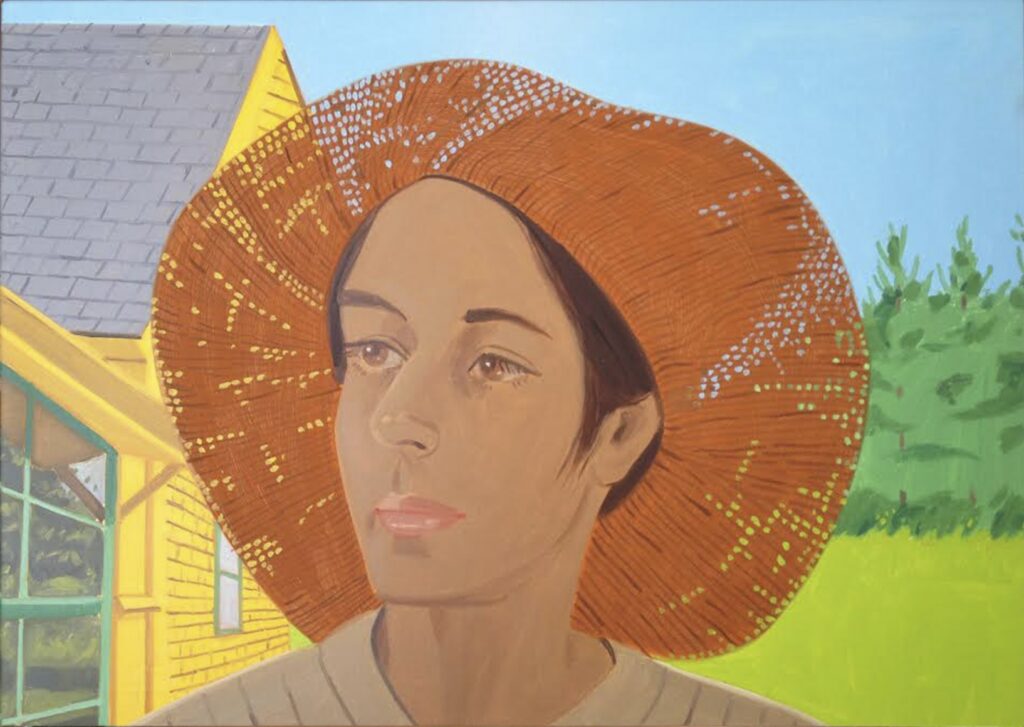rachel campbell @ Craven allen gallery






In Rachel Campbell’s exhibition, “Tell All the Truth But Tell It Slant,” on view through August 27th at Craven Allen Gallery in Durham, twenty oil paintings on canvas and wood panel invite viewers into a realm of electric warmth and leisurely delight. In a summer in which mass shootings, European wars, and judicial attacks on reproductive rights could erode one’s confidence in the human project, these little gems defiantly and playfully affirm life. As a group, they are simply refreshing. We are transported into backyard verandas and into kitchen counters on lazy Sunday mornings and into awkwardly, cramped European loft apartments. Unlike much of contemporary art which is designed to shock audiences with the angst and dissonance of life in the information age, these craftsman-like and at times inelegant images (c.f. the handling of the bricks on the chimney in #4 “Look Through to the Fishes”) remind us to take pleasure in small, quotidian glimpses of joy. A black watch-plaid, flannel-lined coat drapes over a green bar stool here (#9 “The Unseen Guest”); an orchid perches in raking sunlight by a swimming pool there (#15 “Waking Up to The Morning Muse”). Even the scale of these works seems unapologetically designed for display in modest, domestic interiors. Modesty reigns supreme here. One starts to wonder if the collection is organized around a line from an Emily Dickinson poem which bears the same name as Campbell’s show: “The truth must dazzle gradually.” But, don’t be mistaken. Campbell’s world is not in the least bit escapist; it’s tenacious. Her vision throttles us into paying greater attention to the minor miracles present all around us all the time.
Our summons to greater focus starts with the venue itself. If you’ve never been to Craven Allen Gallery, it’s worth the trip. You enter off of Broad Street just north of Duke’s East Campus. You could swing into Moon Dog Meadery, Sho Nuff Seafood or the Green Room billiards hall with sidewalk seating in front of Joe Van Gogh Coffee. The gallery storefront itself boasts tall mid-century glass vitrine windows which haven’t seen a lot of renovation over the years. Eclectic character abounds. A slightly musty, damp scent greets you in the doorway. As you explore further, you see a sampling of the stable artists and the gorgeous custom frames.
The main exhibition space is in the basement – a little, hideaway retreat. It is the perfect place for Campbell’s work. One wall is brick. The other is brown carpet. Those dark, rich tones allow these paintings to explode chromatically. The coolness and quiet of the room also permit a slowing of the heart and breath and eye. The very best of Cambell’s pictures have the languid subject matter of the post-Impressionists such as Emile Bonnard and the raw brutality of Depression-era American realists such as Edward Hopper. There are echoes in the clean, controlled crispness of the edges and thinness of the paint of 20th century art celebrities David Hockney and Alex Katz without their ironic glibness. But, at the end of the day despite whatever influences and derivations might be present, this is a mature vision uniquely and earnestly Campbell’s own.
At first glance, the color seems to be the most astounding quality of this grouping – especially the bold oranges and subtle, vibrating pinks – the latter of which can be seen in the upper lip of the bloom in #14 “Bluebells.” But, Campbell’s pictures are mostly and deftly organized by dramatic line quality and divergent linear rhythms. In #16 “Sunsports III,” the verticals of the porch railing slats and the winged llama planter, the horizontals of the yard and the orange table and the arabesques of the palm fronds intermingle and compete for dominance creating a woven fabric of the good life. The foliage of the spider plant on the far left and the cobalt blue striations in the pillow in the cane chair on the right allow curves to join the dance. The compositional balance of these disparate man-made and organic elements is masterful.
Despite her gifts as a draftsman, some of my favorite moments are when she allows herself to get so lost in her mark-making that her drawing fails or slips. As a result, space and time dissolve and become dreamlike and magical. On the left hand margin of #18 “The Allotments” with the amazing red crabapple petals fallen to the ground, the street sign gets parabolic. The road lifts. The bushes float. Elsewhere, in #1 “Sun Spots,” notice how for the blue pot hosting the heart-shaped caladiums with the red veins, gravity doesn’t seem to be present. Light seems to come from the left, but the ellipses that form the lip of the rim are malformed. This potentially perceived deficiency in execution actually serves Campbell’s overall project well. The pot is particular without having optical specificity. Since it is thus presented generically or symbolically, instead of being confirmed optically as accurate, it hovers in our mind’s eye as more than a single pot in one place at one time. It endures in the viewer’s imagination. This is a quality achieved by only the rarest of poetic geniuses. Campbell is well on her way in this regard.
One of the most endearing and charming aspects of Campbell’s work is how she plays with scale. In #5 “How the Hedge Was,” a hanging pot of geraniums is foregrounded in such a way along a tight orthogonal perspective as to be as big as houses and trees. The artist seems to be reminding her audience that everything is worthy of importance and that the least important detail in a scene could be the most salient actor in the essential drama of memory-making. One of the quirkiest and perhaps most telling features is Campbell’s knack for featuring other paintings in her paintings. In #3 “The Art Collector” and in #9 “The Unseen Guest,” the depictions of paintings get a higher level of finish and clarity, defying atmospheric perspective by which things that recede from the viewer are fuzzier. As a result, the depictions of life seem more alive than life itself. A couch or the counter or even the plants don’t seem to have the same vitality as the paintings. Campbell seems to raise the question: What is the most real?
At times, one might wish for her paint to be a tinge lovelier or painterly, imbued with the same mysterious care as her overall hypnotic vision, but her touch and application are always honest. They never deny that they are pictures made with paint. I adore this bare-knuckles, anti-aristocratic approach.
I also must admit that I don’t personally love her landscapes. I would hazard a guess that she doesn’t either. I think that Campbell’s wheelhouse and muse is the human world void of human physical presence. She seems energized by capturing the vestigial remnants of a dinner party or taking the trash out to the curb. The natural world on its own doesn’t seem to call to her in the same way. This is not to say that the central show piece, #12 “Another Summer III,” featured on the postcard of the waterfall and rocks isn’t successful. It most certainly deserves to be included in a major collection and displayed in the foyer of a corporate plaza here in the Research Triangle Park. It just doesn’t hit me where it counts.
On the other side of the coin, for reasons beyond my ability to analyze, I wish that #19 “The Arrival of Silence” had not yet sold. I would have begged, stolen and borrowed to rustle up the cash. FYI: As of Friday, August 5th, 9 of the 20 had been purchased. In this heartbreaker of a painting, the view of a freshly fallen snow on the street below a window bordered with a Frida Kahlo Hawaiian tropical yellow curtain has a delicate urgency and potent necessity. The piece makes me cry. It makes me wonder what amazing visions I will see on my deathbed as my life “flashes before my eyes.” It makes me grieve all the beauty that I have missed along the way. I can tell that that moment in time (of snow falling on the street and causing a hush) rose up from the abyss of meaninglessness and demanded to be painted by this amazing artist. That moment called out to her, and she listened to its voice. More than that, she ran and got her brushes and canvas and captured this fleeting sweetness. My hope is that this artist continues to answer the bell every time amazing moments call out to her. We, her fans, are better for it. The world needs it. Portfolio — Rachel Campbell (rachelcampbellpainting.com)

